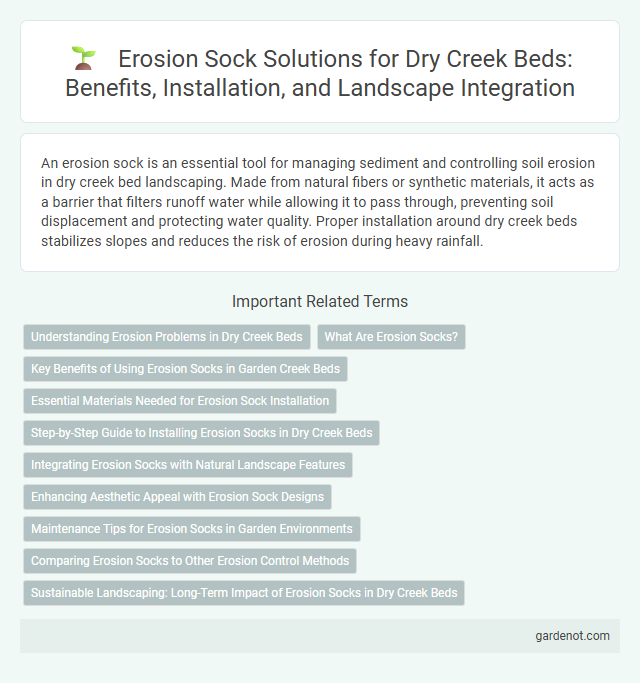An erosion sock is an essential tool for managing sediment and controlling soil erosion in dry creek bed landscaping. Made from natural fibers or synthetic materials, it acts as a barrier that filters runoff water while allowing it to pass through, preventing soil displacement and protecting water quality. Proper installation around dry creek beds stabilizes slopes and reduces the risk of erosion during heavy rainfall.
Understanding Erosion Problems in Dry Creek Beds
Erosion socks help stabilize soil in dry creek beds by controlling sediment displacement and reducing runoff velocity. These geotextile tubes minimize soil loss while promoting vegetation growth, essential for natural erosion control. Implementing erosion socks effectively addresses erosion challenges, preserving creek bed integrity and preventing downstream sedimentation.
What Are Erosion Socks?
Erosion socks are tubular mesh barriers filled with materials such as compost, straw, or mulch designed to control soil erosion in dry creek beds by slowing water flow and trapping sediment. These erosion control devices stabilize slopes and prevent sediment runoff, protecting waterways from clogging and degradation. Made from biodegradable or synthetic fibers, erosion socks provide a sustainable, easy-to-install solution for managing sediment while promoting vegetation growth.
Key Benefits of Using Erosion Socks in Garden Creek Beds
Erosion socks effectively stabilize soil in dry creek beds by reducing runoff velocity and preventing sediment displacement, ensuring long-term soil retention and landscape integrity. These biodegradable tubes provide targeted erosion control around plants and in vulnerable areas, promoting healthier vegetation growth and minimizing maintenance efforts. Their permeability allows for optimal water infiltration while filtering debris, which supports sustainable water management and environmental protection in garden creek beds.
Essential Materials Needed for Erosion Sock Installation
Erosion sock installation in a dry creek bed requires organic fill material such as straw, coconut fiber, or compost to promote soil stabilization and vegetation growth. A durable, UV-resistant mesh fabric made from biodegradable or synthetic fibers encases the fill to prevent displacement during water flow. Securing stakes or rebar are essential to anchor the erosion sock firmly into the creek bed, ensuring effective erosion control and sediment retention.
Step-by-Step Guide to Installing Erosion Socks in Dry Creek Beds
Place erosion socks along the contour of the dry creek bed to slow water flow and capture sediment effectively. Secure the socks with stakes or rebar at intervals of 3 to 4 feet, ensuring firm contact with the soil to prevent displacement during heavy runoff. Overlap adjacent socks by at least 6 inches to create a continuous barrier that stabilizes the creek bed and reduces soil erosion.
Integrating Erosion Socks with Natural Landscape Features
Erosion socks effectively stabilize soil along dry creek beds by conforming to natural contours and supporting native vegetation growth. These biodegradable tubes trap sediment while allowing water to flow, reducing surface runoff and preventing bank collapse. Integrating erosion socks with natural landscape features enhances habitat preservation and promotes long-term creek bed stability.
Enhancing Aesthetic Appeal with Erosion Sock Designs
Erosion socks effectively control soil displacement in dry creek beds while enhancing aesthetic appeal through customizable designs that blend seamlessly with natural landscapes. Incorporating native plants and varying sock materials adds texture and color, creating visually appealing erosion control that complements the environment. These designs promote healthy vegetation growth, stabilizing the soil and preserving the dry creek bed's natural beauty.
Maintenance Tips for Erosion Socks in Garden Environments
Regular inspection and removal of debris are crucial for maintaining erosion socks in dry creek beds, ensuring they effectively stabilize soil and prevent sediment runoff. Replace or reinforce socks showing signs of wear or displacement due to weather conditions or water flow to maintain optimal functionality. Proper watering around erosion socks encourages vegetation growth, which enhances soil retention and longevity of erosion control efforts in garden environments.
Comparing Erosion Socks to Other Erosion Control Methods
Erosion socks provide a cost-effective and environmentally friendly alternative to traditional erosion control methods like silt fences and straw wattles, offering superior sediment retention and ease of installation along dry creek beds. Unlike silt fences, erosion socks conform to uneven terrain and allow better water flow, reducing the risk of water pooling and soil erosion. The natural materials used in erosion socks also promote vegetation growth, enhancing long-term stability compared to synthetic barriers.
Sustainable Landscaping: Long-Term Impact of Erosion Socks in Dry Creek Beds
Erosion socks offer an effective solution for stabilizing soil in dry creek beds by reducing sediment runoff and promoting vegetation growth. These biodegradable tubes are filled with organic materials, helping to filter water while enhancing soil moisture retention and preventing further erosion. Their long-term use supports sustainable landscaping by maintaining ecological balance and protecting water quality in riparian environments.
Erosion sock Infographic

 gardenot.com
gardenot.com